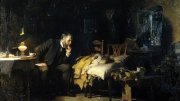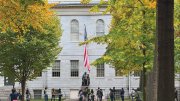A marshall scholarship diverted Frances Brodsky ’76 from enrolling in M.D.-Ph.D. programs after graduation. While earning a doctorate in molecular biology at Oxford, she discovered a preference for pure “bench” science; today, after postdoctoral fellowships and a stint in the biotechnology industry, she is a full professor with joint appointments in the departments of biopharmaceutical sciences and of microbiology and immunology in the schools of pharmacy and medicine at the University of California-San Francisco. She is also coeditor of a new journal in cell biology called Traffic: The International Journal of Intracellular Transport that debuts this January.
Although the demands of her profession keep her busy, Brodsky nonetheless carves out time for a second careeras a writer of detective fiction. Her first book, Principal Investigation, appeared in 1998 under the pen name B.B. Jordan. (The nom de plume, a tradition among mystery writers, helps keep her careers separate.) Secondary Immunization came out this past fall. It features the same amateur detective, Dr. Celeste Braun, a virologist with a talent for stumbling upon mysterious corpses. A third volume, Triplet Code, is well under way.
Why does Brodsky write fiction? “Mainly for fun,” she says. “I’ve always enjoyed reading it, and I’ve read a great deal by C.P. Snow, the English physicist who wrote novels about scientists in the 1950s. It struck me that there is no laboratory science in modern fiction, and I thought it would be fun to try to provide some.” A secondary motive is to make general readers more aware of how science works. She tries to include “one scientific concept per book” with a fair amount of technical detail. The central puzzle is generally related to immunology, and the detective must understand the science in order to solve the mystery. Last but not least, Brodsky constructs her plots and characters to reflect the international nature of scientific research today. Celeste Braun faxes and phones furiously back and forth across oceans and time zones as she fights crime, and there is a recurring group of Japanese characters, since one of the places Brodsky has particularly enjoyed visiting on her professional travels is Japan. “I want my stories to reflect the fact that as a scientist today you have colleagues everywhere,” she says. “One of the eye-opening experiences of doing science is the insight you gain into different cultures.” Principal Investigation has already appeared in a Japanese edition.
Meanwhile, years of work in the laboratory are also beginning to bear fruit. In 1999 Brodsky and her laboratory colleagues published papers in Nature, Cell, and the Journal of Immunology reporting their research on the molecular mechanisms that regulate endocytosis (the process by which cells take up nutrients and hormones through receptors on their surface) and the role of these mechanisms in immune response. Says Brodsky, “It is nice to see the big picture finally coming together.”





